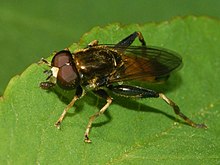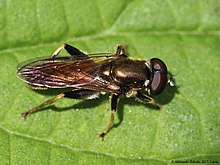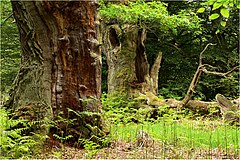Xylota segnis
| Xylota segnis | |
|---|---|

| |
| Xylota segnis. Male showing the row of thorns on hind femora | |

| |
| Female | |
| Scientific classification | |
| Domain: | Eukaryota |
| Kingdom: | Animalia |
| Phylum: | Arthropoda |
| Class: | Insecta |
| Order: | Diptera |
| Family: | Syrphidae |
| Subfamily: | Eristalinae |
| Tribe: | Milesiini |
| Subtribe: | Xylotina |
| Genus: | Xylota |
| Species: | X. segnis |
| Binomial name | |
| Xylota segnis | |
| Synonyms | |
Xylota segnis, The Brown-toed Forest Fly, is a common species of hoverfly.[5]
Etymology
The genus name Xylota is the Latinized form of the rare Byzantine-Greek ξυλωτή [xsylōtē] meaning wooden, while the Latin species name segnis means slipping or lazy, as this hoverfly usually rests on a leaf and it does not fly frequently. The translation of the taxon could be "lazy wood fly".[6]
Distribution
This species has a Palearctic and Nearctic distribution. It is present in all Europe including the Mediterranean, the Caucasus and through Russia to the Russian Far East and Japan. It is also present in the Nearctic eastern parts, in southeastern Canada and northeastern United States.[7][8][9] GBIF species page, with map

Habitat
This species mainly inhabits low bushes in woods.[10]
Description
External images
For terms see Morphology of Diptera
Xylota segnis can reach a length of 10–14 millimetres (0.39–0.55 in) and has a wing length reaching 7–9.5 millimetres (0.28–0.37 in).[10] Thorax is greenish black, with long yellowish hairs. Abdomen is black with a large red or yellowish red patch. In particular, tergites 2 and 3 are yellow or reddish except for the back of tergite 3 which is black. Two rows of long and thick spines are present on hind femora. The front and the hind legs are predominantly yellow, with black or dark brown femora. The compound eyes are reddish and antennae are dark. The wings are slightly brownish with a brown pterostigma, the halteres are light yellow. In males on the hind trochanters there is a long upcurved pointed process. The male genitalia are figured by Hippa (1968).[11] The larva is illustrated in colour by Rotheray (1994) ).[12]
See references for determination.[13][14][15][10]
Biology
This species is polyvoltine, with up to three generations per year. Flight times last from April to September. Adults feed by grazing on anemophilous pollen grazed from surface of leaves.[16] However these hoverflies rarely visits also flowers of various plants, for example Corylus avellana, Rubus idaeus, Euphorbia cyparissias, Aegopodium podagraria, Angelica sylvestris, Heracleum sphondylium, Cirsium arvense and Crataegus species. They also eat honey dew from aphids.
The larvae are normally associated with decaying tree sap,[17] but have also been found in decaying human remains.[18] The larvae overwinter and pupate in the spring.
References
- ^ a b Harris, M. (1780). An exposition of English insects. Vol. Decads III, IV. London: Robson Co. pp. 73–99, 100–138, pls. 21–30, 31–40. Retrieved 16 July 2021.
- ^ Geoffroy, E.L. (1785). [New species]. In A. F. de Fourcroy, Entomologia parisiensis. Parisiis [=Paris]: Aedibus Serpentineis. pp. viii + 544.
- ^ Gmelin, J.F. (1790). Caroli a Linne, Systema naturae per regna tria naturae, secundum classes, ordines, genera, species; cum caracteribus, differentiis, synonymis, locis. Editio decima tertia, aucta, reformata [= Ed. 13.] Vol. 1: Regnum Animale. Lipsiae [= Leipzig]: G.E. Beer. pp. Pt 5, Pp. 2225–3020. Retrieved 26 April 2021.
- ^ Scopoli, I.A. (1763). Entomologia carniolica exhibens insecta carnioliae indigena et distributa in ordines, genera, species, varietates. Methodo Linnæana. Vindobonae [= Vienna]: Trattner. pp. [30] + 420 pp. Retrieved 23 June 2021.
- ^ Stubbs, Alan E. & Falk, Steven J. (1983). British Hoverflies: An Illustrated Identification Guide. British Entomological & Natural History Society. pp. 253, xvpp.
- ^ Johann Wilhelm Meigen, Systematische Beschreibung der bekannten Europäischen zweiflügeligen Insekten, Dritter Theil, Aachen 1822, Seite 211f
- ^ Fauna europaea
- ^ Peck, L. V. (1988). Soós, A.; Papp, L. (eds.). Catalogue of Palaearctic Diptera. Syrphidae. Vol. 8. Amsterdam: Elsevier Science Publishers. p. 363. ISBN 0-444-98932-3.
- ^ Vockeroth, J. R. (1992). The Flower Flies of the Subfamily Syrphinae of Canada, Alaska, and Greenland (Diptera: Syrphidae). Part 18. The Insects and Arachnids of Canada. Ottawa, Ontario: Canadian Government Pub Centre. pp. 1–456. ISBN 0-660-13830-1.
- ^ a b c Coe, R.L. (1953) Diptera: Syrphidae. Handbks.ident.Br.insects, 10(1): 1-98. R.ent.Soc.London. pdf
- ^ Hippa, H. (1968) Classification of the palaearctic species of the genera Xylota Meigen and Xylotomima Shannon (Dipt., Syrphidae). Ann.Ent.Fenn., 34: 179-197.
- ^ Rotheray G., 1993 Colour Guide to Hoverfly Larvae Diptera, Syrphidae in Britain and Europe Dipterists Forum pdf
- ^ Van Veen, M. (2004) Hoverflies of Northwest Europe: identification keys to the Syrphidae. 256pp. KNNV Publishing, Utrecht.addendum
- ^ Van der Goot, V.S. (1981) De zweefvliegen van Noordwest - Europa en Europees Rusland, in het bijzonder van de Benelux. KNNV, Uitgave no.32: 275pp. Amsterdam.
- ^ Bei-Bienko, G.Y. & Steyskal, G.C. (1988) Keys to the Insects of the European Part of the USSR, Volume V: Diptera and Siphonaptera, Part I. Amerind Publishing Co., New Delhi. ISBN 81-205-0080-6.
- ^ Rotheray, Graham E.; Gilbert, Francis (2011). The Natural History of Hoverflies. Tresaith: Forrest Text. pp. 1–348. ISBN 978-0956469212.
- ^ Rotheray, Graham E. (1993). "Colour Guide to Hoverfly Larvae Diptera, Syrphidae in Britain and Europe" (PDF). Dipterists Digest. 1. 9. Dipterists Forum: 156. ISSN 0953-7260. Retrieved 20 December 2013.
- ^ Moffatt, Colin (2013). "Xylota segnis (L.) (Diptera:Syrphidae) found feeding on human remains". British Journal of Entomology and Natural History. 26 (4). British Entomological and Natural History Society: 243. ISSN 0952-7583.
